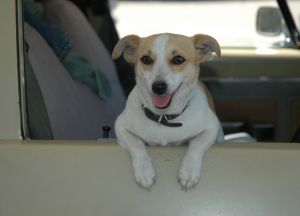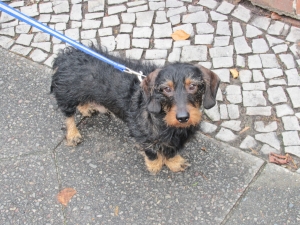 We often say that babies have a unique smell and presence that changes our lives and homes instantly. We’re dead on, and our dogs are well aware of it. Babies don’t smell, or act, like us, and so our dogs may or may not know how to act around a newborn. If you’re getting ready to introduce your dog to your baby (or just a baby in general), take these steps in order to ensure that the first impression sets the foundation for a safe and healthy relationships.
We often say that babies have a unique smell and presence that changes our lives and homes instantly. We’re dead on, and our dogs are well aware of it. Babies don’t smell, or act, like us, and so our dogs may or may not know how to act around a newborn. If you’re getting ready to introduce your dog to your baby (or just a baby in general), take these steps in order to ensure that the first impression sets the foundation for a safe and healthy relationships.
Before baby and dog meet
The nose knows – Your dog’s nose is the key to its mind and heart. He gets to know all about the world around him through his nose. Before you bring a newborn into your home, take baby steps (yup, pun intended), by introducing your dog to your baby’s scent. One of the best ways to do this is to bring home an item – such as a burp cloth – from the hospital, and introduce it to your dog. But it’s not enough to just introduce the scent. You want to set boundaries around this scent, so that you can maintain control of your dog when your baby is nearby.
Challenge your dog to smell the item from a safe distance. This tells your dog that he can smell the item, on your terms. Increase the difficulty of the challenge by leaving the item alone, and seeing if your dog goes to smell it on his own. You don’t want your dog feeling free to approach the item (or your baby) without permission, thus be sure to verbally reprimand the dog if he approaches the item without your permission.
Create a safe zone – Typically, your baby’s safe zone is his nursery, and/or playpen. Before your baby even comes home from the hospital, create clear boundaries for your dog. At first, you want to make sure your dog knows that the nursery is off limits. This could start months in advanced, depending on if you create a nursery ahead of time. Once you feel comfortable with your dog’s respect for boundaries, feel free to let the dog snoop around the area under your supervision. The goal isn’t to make the dog afraid of this space, but to realize that he can’t enter it without your say so.
Time to meet
Walk – Now it’s time for your dog and baby to meet. What’s the best approach? As with most new situations, the best approach starts with exercise. Exercising your dog gets his mind and body stimulated and makes it easier for you to focus his attention after the fact. A tired dog is far easier to manage than one that’s wired. Take your dog for a long walk before your introduction. A 45-minute or hour-long walk would be ideal.
The staggered intro – Most dogs get somewhat (or very) excited when someone comes home. Even if they don’t outwardly seem excited, they are, and that’s not how we want them to be when they meet the new baby. So, first send everyone else (if there is anyone else) inside first, so that your dog can get over his initial excitement. Next, leash the dog (so you have complete control over his movement), and get some treats at the ready.
When your baby comes in the door, have your dog remain in a sit/stay position. Use the treats as needed, as well as the leash. Humans have a tendency to speak in a high tone towards babies. During this introduction, don’t do it. This type of tone excites dogs. Your goal is to keep your dog as calm as possible. Bring the baby to the dog for the initial scent test (don’t let the dog approach the baby first).
Limit the amount of interaction your baby and dog have for the first week. Slowly increase the time they spend together until the baby is just another member of the household.
Life with your dog and baby
While we suggest a slow introduction – over the course of a week – for your dog and baby, there’s one thing you should not do, and that’s give your dog all the attention in the world at the times when your baby is out of the picture. As a result, what you’ll be doing is ignoring your dog when the baby is awake. What will the dog think? He’ll think that he’ll be ignored whenever the baby is up and around. That’s a recipe for competition and hostility.
This is tricky but important: you must give your dog plenty of attention when the baby is around and awake. You want to continue to associate your baby with good things for your dog. It’s a struggle, but will make for a great and safe relationship.
Hey, that baby has a job to do, too
While your baby’s safety is the most important thing to consider in this relationship, you have to respect your dog’s comfort. As your baby gets mobile and active, he may want to start poking at your dog, pulling his tail, sitting on him and more.
Many dogs are ridiculously patient about this, but we all have our tipping point. From day one, be sure to teach your baby how to respect dogs. Teaching them how to pet a dog, and approach one, won’t just protect your baby from your dog, but from other dogs he encounters in his life.
A match made in heaven
Adding a baby to your household could stir up bouts of jealousy with your dog. But if you follow these steps, your dog may view your baby as just another member of the pack who’ll give him love and security.





